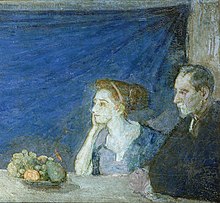Atherton Curtis
Atherton Curtis (April 3, 1863 - October 8, 1943) was an US art collector from Brooklyn, New York City, who settled in Paris in 1903. He was also an author and art historian who donated numerous archaeological items to the Louvre and other museums.

Art Collector
Curtis made his fortune in medicine patents.[1] He was a great connoisseur of graphic art,[2] his collection is exhibited in numerous museums; from the Metropolitan Museum of Art [3] , the Smithsonian Institute to the National Portrait Gallery.
He started his collection in New York in 1896 by purchasing prints from Hokusai and Hiroshige.[4]
He relocated to Paris and had his cases of prints transported there, and whilst he avidly continued his acquisitions with French merchants, in public sales in France, England and Germany. He continued to collect art for the next 40 years.
In order to assemble such an important collection, he often benefited from the advice of Paul Prouté (1887-1981) who’s gallery was saved from the recession by the friendly and financial support of Curtis, as a major American collector of prints. [5]
Curtis collected during his life an extensive selection of prints, both in number (more than ten thousand works of art), representing a variety of eras, techniques and geographic origins.
Archaeological Artifacts
He obtained many Egyptian artefacts from the Montague Ballard [6] excavation in Giza in 1901-1902, which were subsequently bequeathed to a handful of museums in 1938. [7]
Life in Paris
Curtis was an ardent supporter of many contemporary artists during his lifetime, including: Henry Ossawa Tanner and Anders Zorn. He met Tanner in 1897 and became an ardent supporter of his art. Tanner later used the composition of this portrait in a painting of Christ sitting down to dinner with Lazarus and his sister.
His personal collection included works from the late artists; Richard Parkes Bonington[8], Hiroshige, Hokusai and Eugene Isabey [9].
His fellow wealthy contemporaries included Walter Gay [10], who was also a notable collector of artworks. Following Gay’s death in 1937, his widow donated some 200 works of Dutch, Italian, English and French paintings, drawings and illustrations to the Louvre indicating something of the collection's importance.[11]. Curtis and Walter Gay are recorded in the top 3 foreign nationals who in 1934 were “Friends of the Louvre” and important donors. The other was the philanthropist and future US Vice President, Nelson Rockefeller. [12]
Neighbors included Gertrude Stein and Alice Toklas and even during the final years Curtis and his wife had visits from Matisse, Zelda Fitzgerald and F Scott Fitzgerald. [13]
Personal
He was the son of George N. Curtis, a successful merchant, originally from Maine, who moved his business to New York. Curtis was introduced to transatlantic voyages to Europe at a young age, by his father and his mother Eliza.
In 1894 Curtis married Louise Burleigh (1869-1910), who like his father was also from Maine. His new wife was an artist-draftsman and a pupil of Raphaël Collin and Luc-Olivier Merson. Both had already been living in Paris prior to their marriage. Together they formed an extensive art collection. [14]

Curtis was widowed in 1910. His second wife was Ingeborg Flinch (1870-1943) who was originally from Copenhagen, Denmark.
Death
Curtis died on October 8, 1943, in German occupied Paris. His second wife, Ingeborg Flinch, followed him two days later. Like his first wife, she was completely devoted to his cause as a collector. The two wives had also been friends.
Legacy
In 1938 Curtis donated works to the Cluny Museum. The following year he bequeathed a selection to the Bibliothèque nationale de France, including eight hundred Japanese prints.[15] Further parts of his collection were donated in his will in 1943 [16]
Published works
- Curtis, Atherton (1897). Some Masters of Lithography. D. Appleton.[17]
- Curtis, Atherton. How Prints are Made.
- Curtis, Atherton (1903). Auguste Raffet. New York: Frederick Keppel & Co.
Biography
- Paris 1951: The Curtis Collection. Prints and drawings by masters, bequeathed to the Bibliothèque Nationale by the great American amateur, by J. Prinet. Foreword by J. Cain and J. Vallery-Radot, Paris, Bibliothèque Nationale, 1951.
- G. Wildenstein, ‘The enrichments of the National Library’, Gazette des Beaux-Arts, April 1960, no 1095, pp. 1-3, spec. p. 1.
- L. Beaumont-Maillet, collection Collectors at the Cabinet des Estampes, Nouvelles de l'Estampe, December 1993, no 132, pp. 5-27, no 48.
- P. Juhel, Public sales of prints in Paris under the Third Republic. Directory of catalogs (1870-1914), Paris 2016, no 1,549.
References
- "Henry Ossawa Tanner, Portrait of Mr. and Mrs. Atherton Curtis with Still Life - part of the Smithsonian Institute Collection".
- "Etching of Mr and Mrs Atherton Curtis by Anders, Zorn (1860-1920)". 1906.
- "Atherton Curtis at The Met".
- "Atherton Curtis (1863-1943)". gallica.bnf.fr (in French). Retrieved 2020-07-07.
- "Galerie Paul Proute and reference fo support from Atherton Curtis".
- "Montague Ballard Excavations in Giza, Egypt".
- "Egyptian Art in the Age of the Pyramids any Metropolitan Museum of Art Staff, Galeries nationales du Grand Palais (France)and Metropolitan Museum of Art (New York, N.Y.)".
- "Etching by Richard Parkes Bonington - National Portrait Gallery, Washington DC. Art donated by Atherton Curtis".
- "Atherton Curtis catalogue of lithographs by E Isabey produced in 1939".
- "Walter Gay, Expatriate artist and art collector".
- Owens, M., "Paintings of Interiors by Walter Gay and Isabelle Rey," Architectural Digest, 31 October 2012,<Online: https://www.architecturaldigest.com/story/frick-pittsburgh-walter-gay-isabelle-rey>
- Agnès Callu. "La réunion des musées nationaux, 1870-1940: geǹese et fonctionnement".
- "Find a Way: The Inspiring Story of One Woman's Pursuit of a Lifelong Dream by Diana Nyad".
- "AC and LBC marque of their collection".
- "Atherton Curtis Bio from the French National Library".
- "Marque Donated by A Curtis".
- "Author Atherton Curtis - Library of Congress".